"What's that star?
It's the Death Star.
What does it do?
It does Death. It does Death, buddy. Get out of my way!" -Eddie Izzard
Like it was for many people, the original, very first Star Wars movie was one of my favorites as a child. And while there was a lot to be in awe of, the idea of jetting around the Universe in your own private, gargantuan structure, free from planets, Solar Systems, and even the rest of the galaxy was simply the most amazing idea to me.
That's what I wanted: a Death Star. Of course, you know what happens to the Death Star, don't you? At least in the version I remember, Darth Vader shoots down Keith Hernandez, Han Solo saves Luke, Luke blows up the Death Star, and then goes home and reunites with Leia, whom he calls Carrie. (Watch it!)

This image -- of the blown-up Death Star -- was the one that stuck with me. And it wasn't until I was in graduate school, learning about the structures that form in the Universe, that actual astrophysics made me think about the Death Star once again.
This object, Messier 22, is known as a globular cluster. A collection of somewhere around a hundred thousand stars in a sphere that's maybe 100 light years across, globular clusters exist in great abundance around -- but not in -- our galaxy.
Consider that the nearest single star to us is still over four light years away to get an appreciation of how tightly packed these stars are! The Hubble Space Telescope -- taking a deep look inside -- can show you better than I could ever describe on my own.
This 2009 Hubble image is of globular cluster Omega Centauri, which lives some 16,000 light years away from us. All the stars in this image belong to Omega Centauri's core, and the width of the image is 6.3 light years. For comparison, know how many star systems there are within 6.3 light years of us?
Three. The Alpha Centauri trinary star system at 4.3 light-years distant, Barnard's Star, barely making the cut at a distance of 6.0 light years, and... the Sun itself. That's what a globular cluster is. Isolated but full of riches all its own, traveling throughout the galaxy.
Looking around the vicinity of our Milky Way galaxy, there are well over 100 globular clusters -- dense collections of hundreds of thousands of stars -- orbiting and plunging through our galactic plane. Over the entire history of the Universe, each globular cluster has had time to make a mere ten-to-twenty passes through the galaxy, and spend nearly all their time well outside the galaxy itself.
These objects -- globular clusters -- are what I think of as Death Stars. Isolated objects, And as far as we can tell, the Milky Way is awfully typical among galaxies for having a little over a hundred of these "Death Stars."
Andromeda, as a careful observer can find in a night, has over 100 globular clusters as well! These object range from old -- like, many billions of years old -- to the very old. In the case of Messier 22, the first globular cluster I showed you, it's almost as old as the Universe itself, with an estimated age of over 12 billion years! (Not bad, considering the Universe itself has only been around for 13.7 billion years.) Based on what we know about structure formation, we can understand their ages, their distributions in and around galaxies, and their masses. All of that makes sense within our picture of how the Universe works.
But there is a problem with globular clusters, one that has troubled theorists like me. You see, knowing what we know about the Universe -- a Universe that started with the Big Bang, and that contains the measured amounts of radiation, normal matter, dark matter, and dark energy -- there shouldn't just be a couple of hundred globular clusters for every large galaxy. When we do our simulations of structure formation, we get... well, let's just call it a different answer.
Instead of hundreds, our simulations of structure formation predict tens of thousands of globular clusters for each isolated galaxy. And you don't have to be Einstein to realize that that's wrong. But the question, of course, is why that's wrong.
In other words, who destroys all these Death Stars, and how?
Well, if you came by this site for Valentine's Day, you might recall something interesting.
This is the Rosette Nebula, one of the largest star-forming regions in our galaxy, with a total mass of about 10,000 Suns. The central region has the hottest, brightest, youngest stars, and -- as you can also see -- the least amount of hot, pink, star-forming gas. Why is that?
Because these ultra-hot, young stars emit great stellar winds, blowing the gas and dust out of the region where these stars live! And this nebula is in our galaxy. Our quiet, boring, low-rate-of-star-formation galaxy. What would happen if we took two similarly-sized galaxies and -- as structure in the Universe is wont do to over billions of years -- allowed them to merge together?
Instead of star-forming regions containing the mass of thousands of Suns, colliding galaxies (like the Antennae Galaxies, above), have star forming regions containing the mass of billions of Suns! That's right: billions. We even have a special name for galaxies that are doing this right now: Starburst galaxies.
So you can imagine how powerful the stellar winds are in galaxies like this. And in the early Universe, where mergers between similar-sized objects were how galaxies like the Milky Way got so big in the first place, it is conceivable that -- during this intense period of star formation -- the vast majority of globular clusters were blown apart!
This is all just theory, of course. But if we can put this starbursting into our simulation, we should be able to see -- for the first time -- whether the globular clusters come out right! Let's go to the video.
What the simulation shows is that nearly all of the globular clusters get destroyed due to the merger-induced starburst! What you can't see so obviously is that it's the most isolated, largest globular clusters that survive intact. As the researchers from Germany and the Netherlands say themselves:
It is ironic to see that starbursts may produce many young stellar clusters, but at the same time also destroy the majority of them. This occurs not only in galaxy collisions, but should be expected in any starburst environment. In the early Universe, starbursts were commonplace - it therefore makes perfect sense that all globular clusters have approximately the same number of stars. Their smaller brothers and sisters that didn't contain as many stars were doomed to be destroyed.
So that's how the Universe does it! Create a large enough star forming region that the vast majority of your globular clusters are blasted apart; that's how the Universe destroys its Death Stars!
What the researchers don't say is that this may help explain another mystery of globular clusters: blue stragglers.
Inside some globular clusters, there are stars that are hotter, bluer, more massive, and younger than all the other stars found in that cluster. Where did they come from? There are a few ideas, of course, but now there's actually some good evidence pointing towards the simplest idea: that passing through a star-forming region may help form these blue straggler stars, but your cluster needs to be large enough to hold together or be destroyed.

In other words, globular clusters with blue stragglers may be the Universe's failed attempts to destroy that Death Star. And that's how the Universe does it!


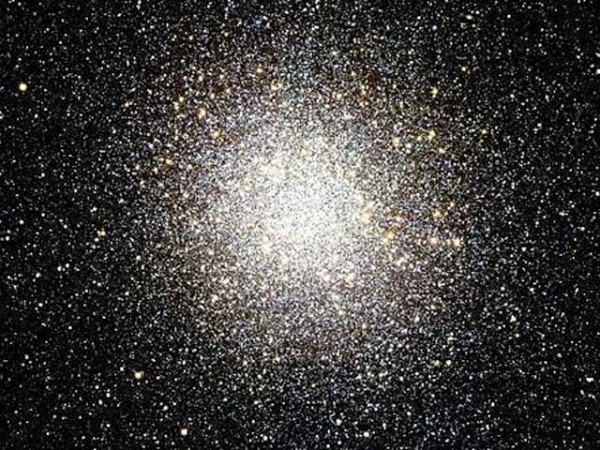
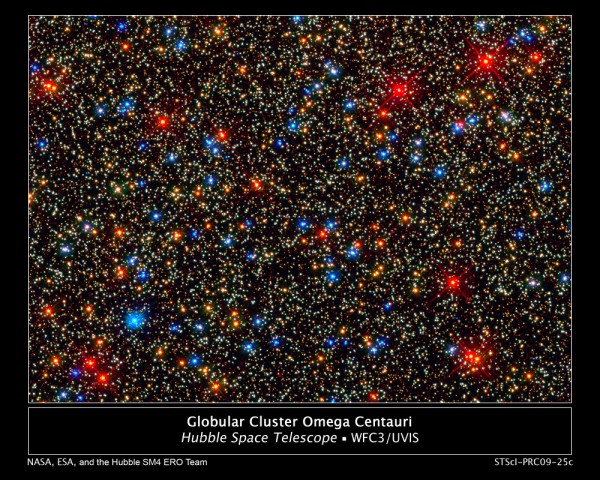
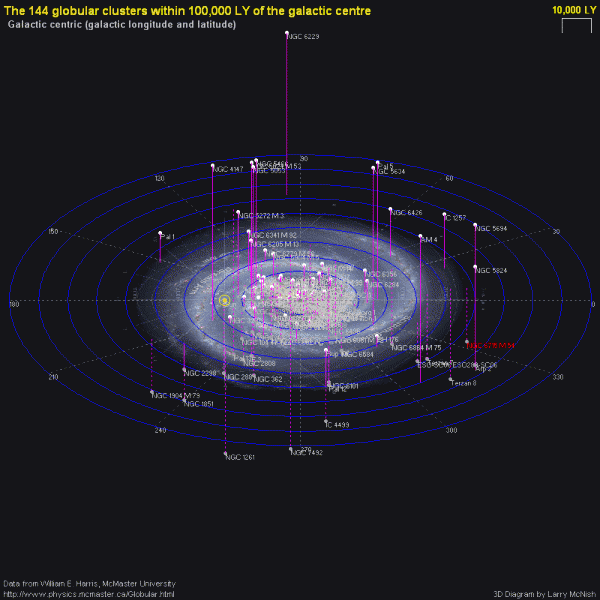

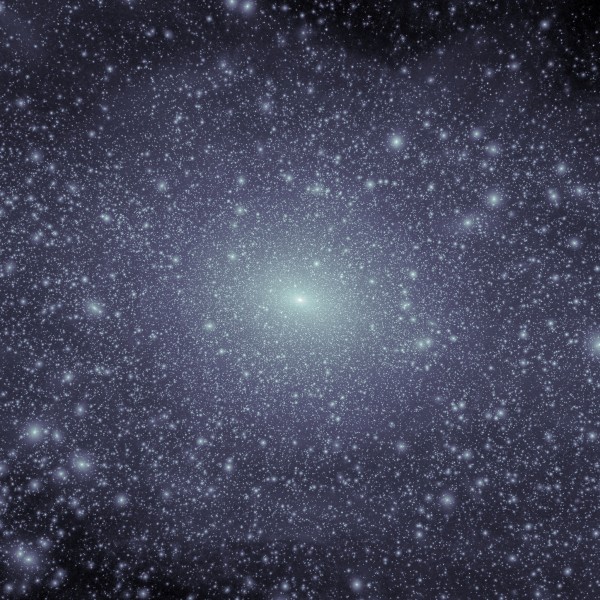


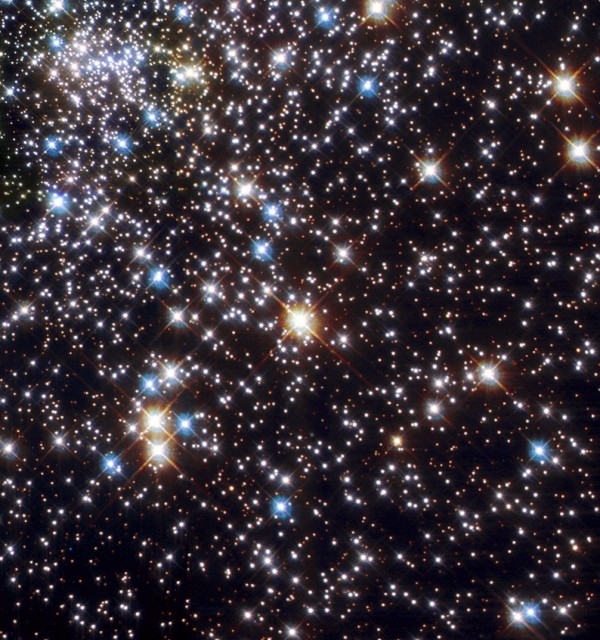
I was wondering what it was like for any people who might have evolved in a globular cluster, so I tried some calculations. If 100,000 stars were all spread evenly within a sphere 100 light years in diameter, my calculations indicate that the average distance between stars would be about 2.14 ly.
Did I do my math right? If so, it's a disappointing answer. I was hoping to discover that aliens in a globular cluster would have a much easier time getting from one star to the next. But that doesn't appear to be the case.
My two favorite things. Science fiction and astronomy!!
Does this mean that, in a decade or two, we'll start seeing Praxis rings around globular clusters?
How frequent are collisions between stars in globular clusters, compared to large galaxies?
@Avi Chapman: considering an uniform distribution may not be the best, but let's give it a try.
r: globular cluster radius
n: number of stars
V = 4/3*pi*r^3 : globular cluster volume
Vs = V/n: average volume per star
Rs : average distance of a star to another
We can approximate Vs = 4/3*pi*Rs^3, so
Rs = cbroot(3/4*Vs/pi) = cbroot(3/4*4/3*pi/pi * r^3/n)
Rs = r/cbroot(n)
So, the average distance between two stars is 1/cbroot(n) of the total globular cluster radius. You estimate a _diameter_ of 100 ly, so your estimate really gives 1,08 ly of separation. Omega Centauri's Wikipedia page says it has "millions" of stars (at least 2 mi, or they wouldn't use the plural) and has a radius around 86 ly. This gives an average distance of 0.7 ly.
I don't think that's too much for those lucky aliens, since knowing there are a lot of stars to visit really cheaply they would probably develop solar sail technology much faster than we are. Not only would they navigate from star to star, they would be PIRATES!
Avi, i think if you consider the globular cluster as a sphere, the star desity becomes more or less 1.74 star every ly. And since it seems the density is bigger at the center, they must be pretty close.
I'm curious about the physics of a cluster's structure. With that many stars in close proximity, why don't we see rotation around a central concentration of mass? Passing back & forth through the galactic plane, I'd think they'd have gotten some angular momentum in there. Am I missing something?
A separation of 1.7 light years would give a period of a couple of million years, Artor (depending on the masses, the globular clusters have a smaller mass than the open clusters or galactic mainstream).
Remember: pluto is 0.015 light years from our sun and its period is 250 years, though the distance is only 1/100th our distance from the sun with our period being 1 year.
Plus with the mass all distributed like that, wouldn't the motion of the stars be more complicated?
This strikes me as very good science; but it seems premature to be convinced of its very tentative conclusions. Following the links, the authors seem to agree.
âIn the nearby Universe, there are several examples of galaxies that have recently undergone large bursts of star formation. It should therefore be possible to see the rapid destruction of small stellar clusters in action. If this is indeed found by new observations, it will confirm our theory for the origin of globular clusters. In that case, globular clusters can indeed be used as fossils to shed more light on the conditions under which the first stars and galaxies formed.â
Nice prediction, let's wait and see. How long will it take to make such new observations to confirm or not Kruijssen's prediction? Anyone know?
Their paper here http://arxiv.org/pdf/1112.1065v1.pdf is a difficult read. Lots of assumptions, tradeoffs and comparison remarks regarding previous simulations. Quickly we realize that this simulation is much more complex previous globular cluster simulation; and apparently, the only simulation that comes even close to agreeing with some key observations. So we really want to believe it.
But complex simulations are messes (e.g. like climate change simulations) that only experts can understand and credibly comment upon. So let's also wait to hear other globular cluster theorists' comments on the reasonableness of this simulation.
The last sentence of their report is appropriately cautious, "If such a generalisation to all dense environments indeed holds, it would suggest that globular cluster populations may be the inevitable outcomes of the large starbursts occurring in the early universe."
Very nice work but let's wait and see if predictions are born out and to hear other experts' comments.
You know, it's really annoying to start reading what you expect will be an interesting blog post only to be stopped dead in your tracks by a glaring grammatical error. It's either "As it was for many people" or "Like many people...."
The rule is simple: like with nouns, as with verb phrases. E.g., As it was in the beginning or Like a virgin.
"Plus with the mass all distributed like that, wouldn't the motion of the stars be more complicated?"
Aye an "orbit" would hardly describe the patterns, would they.
Though if the stars are evenly distributed *to the scale of the separation*, they will still act as if the entire stellar mass consists of only those stars closer to the centre of gravity of the cluster, and only of those closer to the centre than the star under consideration.
PS janvones, yes please, I would like a virgin..!
PPS the elipsis is three dots, and you don't put a period after them.
Oh, meant to say too: I believe the beginning of "Buck Rogers in the 25th Century" used the same graphic to illustrate how he got frozen and went into the future.
Although I was very young, and I've not seen any episodes since then.
By the way, I love globs and they're pretty much my favorite amateur astronomy target. But isn't it kinda weird talking about how the Universe destroys its "Death Stars" when the connection between the DS and globs is that they resemble the *mid-explosion* Death Star which has, by virtue of being a bunch of sparkling bits flying apart at high velocity, already been destroyed? Maybe "how the universe cleans up its Death Star explosion remnants" would be a more accurate if less catchy title? :)
@Wow: Per CMOS, via Wikipedia
"There are two commonly used methods of using ellipses: one uses three dots for any omission, while the second one makes a distinction between omissions within a sentence (using three dots: . . .) and omissions between sentences (using a period and a space followed by three dots: . ...)."
There are many other approaches to the rules for ellipses (two 'l's), and janvones' is close enough to the second there. I often see it without the space, although I can't support that with any style guide offhand, and it then becomes pretty hard to tell whether the period is before or after the ellipsis. It seems pretty tolerable even to me.
I had 'The step and the walk' by The Duke Spirit playing when watching the Death Star blow up clip. Frakkin' awesome!
"and omissions between sentences (using a period and a space followed by three dots: . ...)."
Problem. No sentence after, it was a quote. Fourth dot within quote. No sentence after in quote.
Now, I don't really mind, but when someone goes on about grammar naziism and does the same mistake, it's beholden on every right thinking human to knock the jumped up hitlerian down a peg.
I don't understand (nor do I have sufficient knowledge to calculate reliably) why a globular cluster is ~spherical. On a rotating solid sphere (planet), the north and south poles aren't moving fast enough to stay in orbit of the center, but they don't collapse towards the center because the sphere is solid. Why don't the north and south poles of a globular cluster veer towards the cluster center in short order?
@ KnomDeguerre: It's only because the sphere of a planet is solid (or at least directly interacting via electromagnetic repulsion) that the north and south poles are "stuck" and not free to orbit the center of mass in some other direction. The stars in a glob are all in free space and bound to each other only by gravity. While I'm sure there's a net angular momentum to the glob as a whole and so you could say that the glob is rotating around some axis, individual stars could be moving in a variety of directions.
A disk-like galaxy has a spherical core where it's dense and old. Much like the entirety of a globular cluster.
And the globular clusters orbit their parent galaxy in a rough sphere, not a plane.
"Big balls of balls" is quite common in the universe. It's the orbital planes that are the oddity...
It's also a fact that some of the older globular clusters have undergone collapse, where the core is much denser than the remainder. This may be the result of collision and the ejection of near-misses tending to throw some stars right out of the cluster and reducing the total angular momentum left within it. This may be the necessary result of such a spherical formation.
A disk-like galaxy has a spherical core where it's dense and old. Much like the entirety of a globular cluster.
And the globular clusters orbit their parent galaxy in a rough sphere, not a plane.
"Big balls of balls" is quite common in the universe. It's the orbital planes that are the oddity...
It's also a fact that some of the older globular clusters have undergone collapse, where the core is much denser than the remainder. This may be the result of collision and the ejection of near-misses tending to throw some stars right out of the cluster and reducing the total angular momentum left within it. This may be the necessary result of such a spherical formation.